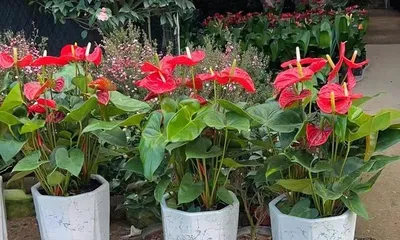Anthurium is a common tropical plant, beloved by many for its vibrant flowers and unique leaf shapes. However, many growers encounter a problem when caring for Anthuriums: can they be exposed to direct sunlight? This question relates to the growth and development of the Anthurium and also determines the success of our care. Let's take a detailed look at the sunlight requirements and care methods for Anthuriums.

I. The Growing Environment of Anthurium
Anthurium is a tropical plant with high requirements for environmental factors such as temperature and humidity. In a suitable growing environment, Anthurium can grow healthily and bloom; otherwise, problems like yellowing and withering may occur.
II. Anthurium's Sunlight Requirements
As a tropical plant, Anthurium has a high demand for sunlight. Adequate sunlight can promote photosynthesis, enhance the plant's disease resistance, and improve nutrient absorption. However, excessive sunlight can cause the leaves to turn yellow, dry out, or even get scorched.

III. Anthurium's Sunlight Exposure Time
Anthurium needs sufficient sunlight exposure. It is generally recommended to expose it to direct sunlight for about 4-6 hours a day, not exceeding 8 hours. If the sunlight is too intense or the exposure is too long, you can consider moving the Anthurium to a partially shaded area or under a shade net.
IV. Sun Protection Measures for Anthurium
During the hot summer months, Anthurium is susceptible to sun damage and requires appropriate protective measures. You can hang a shade net around the Anthurium or place it in a partially shaded area. At the same time, it is important to maintain the humidity around the plant to avoid excessive dryness.
V. Water Management for Anthurium
Proper watering can enhance the growth rate and quality of Anthurium. However, overwatering can lead to root rot, affecting the plant's growth. When watering, pay attention to controlling the amount and frequency to ensure the soil is moderately moist.

VI. Fertilizer Application for Anthurium
Appropriate fertilization can promote the growth and flowering of Anthurium, improving the plant's quality. However, excessive or improper use of fertilizer can harm the Anthurium and even lead to diseases. When fertilizing, pay attention to the type and amount of fertilizer to avoid over-fertilization.
VII. Pruning for Anthurium
Proper pruning can promote the metabolism and growth of Anthurium. However, excessive pruning can reduce the number of flower buds, affecting the plant's quality. When pruning, it is important to be moderate and avoid excessively cutting the main stem and branches.
VIII. Soil Management for Anthurium
Soil is one of the important factors for Anthurium growth. Suitable soil can provide the plant with the necessary nutrients and moisture. When planting Anthurium, choose appropriate soil and carry out proper conditioning and management.
IX. Disease and Pest Control for Anthurium
During the growth process, Anthurium is susceptible to various pests and diseases, such as aphids and powdery mildew. Appropriate pest and disease control measures should be taken to prevent their spread and occurrence.
X. Seasonal Management for Anthurium
The growth and flowering of Anthurium are influenced by the seasons, so different management measures should be taken in different seasons. For example, in summer, pay attention to sun protection and moisture retention; in winter, focus on insulation and cold protection.
XI. Transplanting Method for Anthurium
When the Anthurium grows too vigorously or the roots become too dense, transplantation can be considered. When transplanting, pay attention to keeping the root system intact and water and fertilize appropriately afterwards.
XII. Propagation Methods for Anthurium
Anthurium can be propagated by methods such as division, cuttings, and sowing. Among these, division and cuttings are more commonly used. The specific method should be chosen based on the actual situation.
XIII. Care Precautions for Anthurium
Caring for Anthurium requires attention to many details, such as regular weeding, irrigation, and fertilization. At the same time, it is also important to maintain a clean environment around the Anthurium to prevent pests and diseases.
XIV. Daily Inspection of Anthurium
Regularly checking the growth status and health of Anthurium can help identify and address problems early. In daily care, pay attention to regularly inspecting the leaves, flowers, and roots of the Anthurium.
XV. Anthurium Care
Caring for Anthurium involves managing aspects such as light, water, fertilizer, and pruning, as well as timely pest and disease control and seasonal management. Only by considering all these factors comprehensively can Anthurium grow healthily and display its most beautiful side.